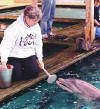|
Stimulus Control |
|
|
|
|
|
1.
Definitions 2.
Identify
concepts from video clips
(Refer to Clucking
Calculator.) 5.
Word search |
|
|
Click on the thumbnail to enlarge. |
Discrimination Training |
|
|
Discrimination training involves reinforcing a behavior (e.g., pecking) in the presence of one stimulus but not others. In the picture to the left, one of the Bailey’s chickens was presented with two note cards; one card contained a red circle, while the other card contained a blue circle. A peck on the red circle was reinforced, while a peck on the blue circle was not reinforced (this process involves differential reinforcement). Eventually, the chicken only pecked the red circle. The Baileys also used note cards with different shapes (e.g., circles v. squares) to demonstrate discrimination training involving geometric figures. With discrimination training, animals like chickens are said, in everyday language, to be able to "tell the difference" between shapes (like circles or squares) or colors (like red or blue), as long as the animal has the appropriate sensory apparatus, like color vision. |
|
|
|
|
Click on the thumbnail to enlarge. |
Discriminative Stimulus (and Generalization) |
|
|
The discriminative stimulus is the cue (stimulus) that is
present when the behavior is reinforced. The animal learns to exhibit
the behavior in the presence of the discriminative stimulus. In the
example above, the red circle was the discriminative stimulus (sometimes
abbreviated SD, pronounced "S-Dee".) In
the case of note cards with squares and circles, if the Baileys had
reinforced pecking a square rather than a circle, the SD would
have been the square. (To complicate the matter, animal trainers like to
call the SD the "hot stimulus," because behaving in the
presence of that stimulus will get the animal a reinforcer.) Further,
the animal does not have to interact with the discriminative stimulus - for
example, in the post-card vending chicken, a light signals the availability
of reinforcement, but the chicken does not have to interact with the light
and only has to pull a loop. Refer to the picture to the left. The staff of
ABE often used "targets" to help control the behavior of
animals. In many demonstrations, the animals were taught to touch the
target with their noses. These targets were "hot" stimuli and,
therefore, discriminative stimuli. In short, discriminative stimuli
occur before the behavior and are said to control the behavior (refer back to
the three-term contingency). (Generalization
occurs when the animal responds to stimuli that are similar to the SD, but
not exactly the same stimuli that were used in training – for example, to red
circles of slightly different hues, to lines of slightly different lengths,
to circles of slightly different diameters.) |
|
|
|
|
Click on the thumbnail to enlarge. |
S-delta |
|
The S-delta (SD) is the stimulus in the presence of which
the behavior is not reinforced. At first during discrimination training,
the animal often responds in the presence of stimuli that are similar to the
SD. These similar stimuli are S-deltas. Eventually, responding to the
S-delta will be extinguished. (Animal trainers call the S-delta the
"cold stimulus.") Let's take
the example of pecking a red circle. The trainer makes two cards, one
with a red circle and one with blue circle. Pecking the red circle is
reinforced, but not pecking the blue circle. (At first, the chicken might
peck both circles, but if pecking is only reinforced in the presence of the
red circle, pecking will eventually occur only in the presence of that
circle.) The blue circle would be an S-delta. |
|

